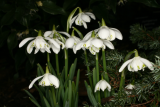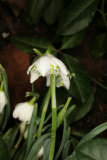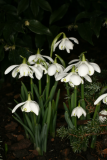Additional notes (click to expand)
Medicinal
Prescription only medicine: Acetylcholinesterase inhibitors
The chemical galantamine is sourced principally from the Caucasian snowdrop, Galanthus woronowii, but is present in our ‘English’ snowdrop and related species. It is a competitive, reversible, acetylcholinesterase inhibitor that increases brain acetylcholine, a chemical of great importance in cerebral function. As such it has been recommended for ameliorating the symptoms of mild to moderate Alzheimer’s disease, but not for mild cognitive impairment due to increased mortality in US clinical trials.
Some authors have regarded Homer’s ‘moly’ (used by Circe to poison Odysseus’s men) as being this
plant, but 16th-century herbalists (and Linnaeus) were clear that ‘moly’ was an Allium, a member of the onion family. Johnson (Gerard, 1633) calls it the bulbous violet, Viola theophrasti, Leucoium or snowdrop, and says there is no mention of it by ancient writers and that it has no medicinal use. Fuchs (1542) calls it Leucoium theophrasti, known to Pliny, and Viola alba, and concurs that it is of no use. The woodcuts in these herbals are immensely useful in identifying G. nivalis despite its alternative names.
Oakeley, Dr. Henry. (2011). A Year in the Medicinal Garden of the Royal College of Physicians, revised edition. Royal College of Physicians, London. p.11
link
Nomenclature
From Greek- gala, milk and anthos, flower. Nivalis- snow white, growing near snow.
Stearn, W.T. (1996). Dictionary of Plant Names for Gardeners. Cassell. p.147
Other use
Galantamine and its derivatives was approved by the FDA in 2001, and is largely used as a memory-improvement supplement for sufferers of Alzheimers disease and mild dementia. Only recently has the substance been used as an oneirogen, or a dream enhancing supplement.
Historically, the first evidence for using the memory-increasing properties of galantamine come from Homer’s Iliad, where, some scholars argue, Odyessus uses the snowdrop flower to combat the effects of memory loss (Duvoisin, 1983). This natural supplement has been used for centuries in China as a memory enhancer, and was even noted by the ancient Greeks for its powerful mind-inducing effects.
Joint Nature Conservation Committee http://jncc.defra.gov.uk/page-5721-theme=textonly
link
Phytochemistry
Galantamine is an alkaloid known form several members of the Amaryllis family (Amaryllidaceae), and the idea for developing a medical product for AD from these species seems to be based on the local use of one of these species in a remote part of Europe. It has become an important therapeutic options used to slow down the process of neurological degeneration in AD. Its development from little known observational studies in the Caucasus Mountains (Southern Russia), to the use of this drug in Eastern European countries (esp. Bulgaria) in the treatment of poliomyelitis and ultimately to the recent introduction onto Western markets in the treatment of AD (Heinrich, 2010). Galantamine was first isolated from snowdrop (Galanthus spp.) but today it is obtained from Narcissus spp. and Leucojum spp. as well as synthetically (Heinrich and Lee Teoh, 2004). According to unconfirmed reports, in the 1950s, a Bulgarian pharmacologist noticed the use of the common snowdrop growing in the wild by people who were rubbing it on their foreheads to ease nerve pain. Also, some of the earlier publications indicate the extensive use of snowdrop in Eastern Europe, such as Romania, Ukraine, the Balkan Peninsula, and in the Eastern Mediterranean countries. However, Mashkovsky and Kruglikova-Lvov (1951) published the first work that establishes the acetylcholine esterase inhibiting properties of galantamine isolated from Galanthus woronowii. Poliomyelitis was one of the first indications for galantamine, especially in the Eastern and Central European, since the compound enhances nerve impulse transmission at the synapse. Studies indicating blood–brain barrier penetration of the alkaloid pioneer the development of CNS-related indications. Based on the knowledge of galantamine in both the peripheral and central nervous system, many countries in Eastern Europe used it as an acknowledged treatment in Myasthenia gravis and muscular dystrophy, residual poliomyelitis paralysis symptoms, trigeminal neurologica, and other forms of neuritis. A crucial step for the success of galantamine as a medicine against AD was based on the synthesis developed in the mid-1990s. The scientific rationale for using cholinesterase inhibitors in the management of AD is based on the cholinergic hypothesis. Impairment of the central cholinergic system represents one hallmark of AD, which is characterized by loss of cholinergic neurons in the forebrain and a marked decrease in the activity of choline acetyltransferase. Overall, galantamine represents an example for the successful ethnobotany-driven development of a natural product into a clinically important drug (Heinrich, 2010). In the last years, focus on AD drug discovery is shifting away from AChE inhibitors and a large number of other targets are currently being explored. However, mounting evidence obtained in vitro and in vivo, suggests that various traditionally used plants significantly affect key metabolic alterations culminating in AD-typical neurodegeneration. While the impact of the aforementioned traditional used plants on AD has been reviewed comprehensively (Howes et al., 2003; Houghton and Howes, 2005; Akhondzadeh and Abbasi, 2006; Yan et al., 2007).
Joint Nature Conservation Committee http://jncc.defra.gov.uk/page-5721-theme=textonly
link
Toxicity
Toxic
Professor Anthony Dayan, 2022
Galanthus nivalis f. pleniflorus 'Flore Pleno'
Family: AMARYLLIDACEAEGenus: Galanthus
Species: nivalis
Form: pleniflorus
Cultivar: 'Flore Pleno'
Distribution summary: Mid to S.Europe, W. Asia, Caucasus
Habit: Bulbous
Hardiness: H5 - Hardy; cold winter
Garden status: Currently grown
Garden location: Plants of the World (C)
Flowering months: January, February
Reason for growing: Medicinal, toxic, prescription only medicine

 .JPG)
 .JPG)

